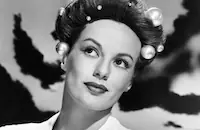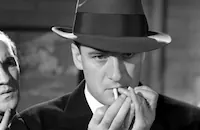Director and producer Joseph Lerner’s independent film noir Guilty Bystander (1950) ushered in a new era of New York City filmmaking. It also served as the last hurrah for several Hollywood actors who found themselves in a transitional period in their lives. Since its release in 1950, Guilty Bystander languished in obscurity for years and eventually fell into the public domain. The film was restored in 2020 by L’Immagine Ritrovata from BFI’s 35mm print discovered by Noir Alley host Eddie Muller.
Guilty Bystander stars Zachary Scott and Faye Emerson, in their fourth and final film together. They play a divorced couple searching for their kidnapped toddler son. Scott stars as Max Thursday, a former police officer down on his luck, who suffers from alcoholism and works as a house detective at a seedy hotel. Co-stars include Mary Boland in a rare non-comedic role as the hotel owner and Sam Levene, a character actor best known for playing screen heavies, as the police captain. The story was adapted for the screen by Don Ettlinger and based on a novel by Wade Miller, one of several pseudonyms for the crime writing duo H. Bill Miller and Robert Allison Wade.
The film is the brain child of Joseph Lerner, a former actor turned filmmaker who wrote and produced three documentaries about the Olympic Games and went on to direct six feature films, four of which were made in New York City. According to film professor Richard Koszarski, most film production in New York City had ground to a halt in 1937, with the exception of “cartoons, newsreels, documentaries and industrial films.” Feature filmmaking had migrated to Hollywood and wouldn’t return to the Big Apple until the mid-to-late 1940s. Lerner was instrumental in revitalizing New York City productions. Koszarski goes on to claim that “no history acknowledges the contributions of Joseph Lerner in helping to reconstruct this industry from the scraps that had survived after 1945.”
This post-War renaissance would soon give way to classics like The Naked City (1948), On the Waterfront (1954) and 12 Angry Men (1957). Lerner had to start from scratch as a filmmaker without the resources Hollywood studios provided. He got an education in feature filmmaking with his first movie The Fight Never Ends (1948), a very low-budget biopic about Joe Louis starring the prizefighter as himself and featuring other talent like Ruby Dee and The Mills Brothers. Made for a mere $18,000, it was picked up by Loew’s and proved to be a successful first venture, one that allowed Lerner to acquire capital for his following productions.
Lerner was soon on the move. He started his own production company Laurel Films, partnered with distributor Film Classics and often shot on location and at the Fox Movietone studio in New York City. For Guilty Bystander, assembling the cast and crew was an exercise is networking. His wife Geraldine Lerner was his film editor and oversaw much of the audio production. For simplicity, no sound effects or dubbing were used and filming required the sound to be near perfect. When Lerner’s go-to production designer Howard Saulter was unavailable, he sought out Leo Kerz who had been working on a stage production of Bloom in Love. Kerz and Lerner worked closely on the look of the film which included dressing Faye Emerson in blue and Zachary Scott in brown. While the film is in black-and-white, Kerz felt that these colors would best represent the characters on screen. Kerz also made sets with mobile pieces that could be moved allowing for different camera angles.
For the lead role of Max Thursday, Lerner was able to cast Scott, a Warner Bros. contract star best known for his role in Mildred Pierce (1945). According to writer Marya E. Gates in the article "The Anguish of Zachary Scott," “by 1949, Zach was struggling for control over the films in which he starred, asking Warner Bros. for a three-month release from his contract to star in Guilty Bystander. Zach was allowed this leave - but not without a studio-imposed penalty of an additional 52 weeks added to his contract.” This was a turbulent time in Scott’s life. He was suffering from a box-office slump, his studio contract was coming to an end, as was his marriage to his first wife Elaine. Guilty Bystander was one of many independent productions Scott would star in throughout the 1950s. His co-star Faye Emerson had all but retired from film by this time and it’s very likely that she was cast because of her connection to Scott. Emerson had left her Hollywood career behind to navigate the New York City social scene. In 1950, her troubled marriage to Elliott Roosevelt came to an end and she soon focused her efforts on launching a successful television career with The Faye Emerson Show.
Guilty Bystander is also notable for being the final film role for Mary Boland, Jed Prouty and J. Edward Bromberg. Boland was good friends with Scott and his wife Elaine and had recently returned to the New York theater scene where she would remain until her retirement. When Lee J. Cobb expressed interest in playing Max Thursday, Lerner quickly turned him down, most likely because of his involvement with the Hollywood blacklist. Lerner cast his good friend J. Edward Bromberg as one of the key villains in the film. Bromberg was a founding member of the Group Theatre and became investigated by the House Un-American Activities Committee around the time of filming. The stress of the ordeal affected his health and he died of a heart attack a year after making Guilty Bystander. The rest of the cast boasted New York City actors including Kay Medford and newcomers Harry Landers and Dennis Patrick. John Marley, best known for Love Story (1970) and The Godfather (1972), has a brief uncredited role as a bartender.
Given the star power of the movie’s two leads, Lerner’s budget for Guilty Bystander grew to $450,000, much more than any other production he had been involved with. Filming took place between August and September 1949. According to the New York Times, Lerner paid the Board of Transportation a mere $25 to rent a five-car subway train and hire two conductors to run it. The temporarily abandoned Court Street station in Brooklyn was used for the film’s chase sequence. Guilty Bystander premiered April 20th, 1950 at the Palace Theater in Manhattan. The film received mixed reviews. New York Times critic Bosley Crowther praised the performances of Scott, Emerson and Boland and while he felt that Lerner and his team had done “a fairy respectable job” the story to him was “patent, contrived, and superficial.” However, it appealed to audiences and proved to be quite profitable. Years later, thanks to its restoration, Guilty Bystander is being rediscovered as a film noir hidden gem.
























